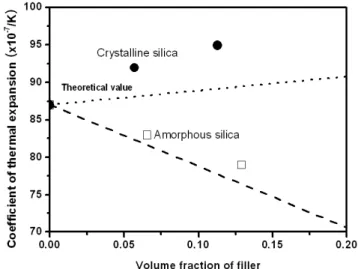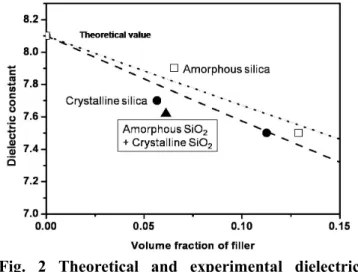P1-62 / C. Lee
IMID 2009 DIGEST •
Abstract
Lowering the dielectric constant is one of the important issues for the efficiency and the power consumption in the plasma display panel (PDP) industry. This study examined the effect of the addition of ceramic filler (up to 10% of crystalline and amorphous silica, respectively) to a B2O3-ZnO- P2O5 glass matrix on the dielectric, coefficient of thermal expansion, etching behaviors and residual stress for the barrier ribs in plasma display panels. The dielectric constant of barrier ribs is affected by containing two types of SiO2 filler for the barrier rib composition in PDP.
1. Introduction
The issue of plasma display panel (PDP) has always been important in high efficiency, resolution, picture quality and low cost [1-2]. The dielectric constants of materials, particularly glasses and glass-ceramics, have attracted considerable interest in the display industry with the goal of improving the efficacy of the displays. Lowering the dielectric constant of the dielectrics is a key solution for reducing the power consumption of PDP [3-4]. Barrier ribs of the PDP require a high optical reflectance, low dielectric constant, and comparable coefficient of thermal expansion (CTE) and residual stress to the back glass panels.
In order to meet such complicated requirements, it is desirable to use ceramic filler-added glass composites instead of a monolithic material. Because the tuning of material properties is more suitable if the composites were used [4]. Previous researches show that the barrier ribs were consisted of glasses and ceramics fillers such as TiO2, Al2O3, ZrO and ZnO [5].
However, the dielectric constants of the composites were higher than nine due to the high dielectric constant of TiO2, Al2O3 and ZnO ceramic fillers. New
filler-added composites are required for the low power consumption within the optimal CTEs(80±5×10-7/K)
between the glass substrate and the barrier ribs. Hwang et al. [6] showed the residual stress between the PDP glass substrate and the dielectric layer having different CTE. They suggested that much difference of CTEs was led to higher residual stress in glass substrates with compressive and tensile stress.
This study was designed to develop the B2O3
-ZnO-P2O5 (BZP) composites with silica ceramic fillers
(crystalline and amorphous SiO2) for barrier ribs.
Moreover, the barrier ribs were fabricated by etching with two layers of composites. It is well known that the barrier ribs fabricated by a single layer have smaller discharge space than a composite with two layers during etching in PDP industries. The fillers have the same chemical composition so that the interface of two different layers is more attractive than any different composites. Furthermore, the CTE of composites were completely different. Two different CTE’s (95×10-7/K and 79×10-7/K) of composites for
barrier ribs are good advantages for preventing the deformation of the glass substrate and stable shape of barrier ribs [6]. The glass substrate is reported to be deformed by mismatching the coefficient of thermal expansions between barrier ribs and glass substrate (PD200: 83×10-7/K; Asahi Glass, Tokyo, Japan) in
large panels (42’ HD or 50’ HD). Furthermore, two different dielectric constants of fillers for barrier ribs are good advantage for lowering dielectric constant.
The purpose of the present paper is to optimize the CTE of barrier rib and the residual stress to glass substrate in PDP. Simultaneously, we aimed the lower dielectric constant of barrier rib.
2. Experimental
Design of a new barrier rib with low dielectric constant
and thermal stability
Chungyong Lee
1*, Seongjin Hwang
1, Youngjin You
2,
Sangho Lee
2and Hyungsun Kim
11
School of Materials Engineering, Inha University, Incheon, Korea
2Phoenix PDE Corp., Gyeongsangbuk-do, Korea
Phone: 82-32-860-7532, E-mail: kimhs@inha.ac.kr
P1-62 / C. Lee
• IMID 2009 DIGEST
A commercialized B2O3-ZnO-P2O5 frit was used for
barrier ribs in this work. As the ceramic filler, two types of SiO2 (crystalline and amorphous silica) were
mixed with the glass frit by the different contents of barrier ribs as shown in Table 1.
TABLE 1. Compositions of various composites according to the mixing rate of glass frit and SiO2 fillers (crystalline and amorphous silicon) in wt %
Sample
1 Sample 2 Sample 3 Sample 4 Sample 5 Glass frit 95 90 95 90 95 SiO2 (crystalline) 5 10 0 0 SiO2 (amorphous) 0 0 5 10 5
B2O3-ZnO-P2O5 frits mixed with different contents
of fillers were fired at 550oC for 30min. The
coefficient of thermal expansion was measured by dilatometer under 5oC/min. The microstructures of
fired samples were observed by a scanning electron microscopy and the dielectric constant was measured using a LCR meter (E4980A, Agilent, USA).
The B2O3-ZnO-P2O5 glass frits, SiO2 fillers and
vehicle were mixed and made to a paste with 3 rolls mill (Exakt 50, Exakt, Germany). The pastes were spread on the soda-lime glass substrate using a table coater and fired in a furnace at 550oC. The residual
stress of substrate was observed by a strain viewer (HKL-MSV-P24, HK Lab., Korea).
3. Results and discussion
Figure 1 shows that the theoretical CTEs of BZP glass and composites were slightly different to the experimental CTEs. The CTE of 10 wt% of crystalline and amorphous silica ceramic filler-added BZP was 95×10-7 / K and 79×10-7 / K, respectively. This result is
related to the fabricated condition (fired at 550oC) of
the crystalline and amorphous silica and to the value of CTE with the reference [7]. While the values of crystalline and amorphous silica were determined from thin layers [7], the composites were investigated with pellets.
The theoretical dielectric constants of SiO2 fillers
added BZP glass composites were similar to the experimental dielectric constants in Fig. 2. The theoretical value in Fig. 2 was predicted by Turner’s equation (1) [8], f f g g f f f g g g C
V
K
V
K
K
V
K
V
+
+
=
α
α
α
(1)where α is the CTE, V is the volume fraction, K is
the bulk modulus (= E/3(1− 2ν) where E is the
elastic modulus and ν is Poisson’s ratio), and
subscripts g, f, and c denote the glass matrix, filler, and composite, respectively.
Fig. 1 Theoretical and experimental CTE of the BZP glass and composites with increasing the content of crystalline and amorphous silica fillers.
The dielectric constant of composites decreases gradually with increasing the content of fillers in Fig. 2. The dielectric constant of composites consisted of 10wt% of fillers are namely 7.5. Based on the results, the composites consisted of 10wt % of the crystalline and the amorphous silica ceramic filler-added B2O3
-ZnO-P2O5 (BZP) fired at 550ºC had a similar
dielectric constant (7.5). The theoretical value was predicted by Mixture rules [7, 9].
Crystalline SiO2 filler has higher CTE than the
glass substrate. However, amorphous has lower CTE. Thus, if the fillers are mixed, the CTE of barrier rib composites are assumed more optimal to the glass substrate. Furthermore, the dielectric constant of two filler mixed composites was lower than one filler mixed composites in Fig. 2. The dielectric constants of two filler mixed composite were slightly lower than the single filler added composite. It should be related to the complex microstructure of composites [10].
P1-62 / C. Lee
IMID 2009 DIGEST •
Fig. 2 Theoretical and experimental dielectric constant of the BZP glass and composites by the content of crystalline and amorphous silica fillers.
The residual stress shows the glass substrate with barrier ribs having different CTE. In the residual stress images, red area shows that the glass substrate has the compressive stress and the blue area shows that the glass substrate has the tensile stress. Fig. 4 shows that the stress was slightly increased by the content of filler. However, the barrier rib composed of BZP glass and 10wt% amorphous SiO2 was cracked on the glass
substrate after firing at 550oC. We supposed that the
compressive stress of glass substrate can be removed by the delamination between the glass substrate and thick film. As this result, the different filler contents of composites lead to the different residual stress of the glass substrate.
Fig. 4 The residual stress images of the glass substrates (thickness: 19mm) with thick film (thickness: 120µm) after firing at 550oC, consisted of BZP glass and SiO
2 (amorphous and crystalline).
4. Summary
We investigated the dielectric constant of barrier rib composites and the residual stress between the barrier ribs based on the B2O3-ZnO-P2O5 glass frit with SiO2
fillers and the substrate. It shows that the dielectric constant of two filler-mixed composite are able to reduce the dielectric constant than using single filler added composite and control the residual stress to the glass substrate.
Acknowledgements
This work was supported by the Ministry of Commerce,
Industry and Energy (MOCIE) through the New Growth Engine Project.
5. References
[1] C. Lee, D. Kim, Y. You, S. Lee, S. Hwang and H. Kim, IMID Technical Digest, pp823-26 (2008).
[2] S. M. Ryu, L. S. Park and D. Y. Yang, IMID
Technical Digest, pp316-19 (2007).
[3] Y. S. Kim, S. Y. Lee, S. K. Hong and H. J. Jeon,
J. Am. Ceram. Soc., 84 [7], 1470-74 (2001).
[4] E. Chong, S. Hwang, W. Sung, H. Shin and H. Kim, Int. J. Appl. Ceram. Technol., 6 [2] 295-301 (2009).
[5] S. G. Kim, J. S. Park, J. S. An, K. S. Hong, H. Shin, and H. Kim, J. Am. Ceram. Soc., 89 [3] 902–907 (2006).
[6] J. Hwang, T. Lim, N. Kim and H. Kim, SID Technical Digest, pp389-92(2008).
[7] R. E. McMillan and R. P. Misra, IEEE Trans.
Electr. Insul., El-5 [1] 10-18 (1970).
[8] P.S. Turner, J. Res. Nat. Bur. Stand., 37, 239 (1946)
[9] W. D. Kingery, H. K. Bowen and D. R. Uhlmann,
Introduction to ceramics (1975)
[10] J. Kim, S. Hwang, W. Sung and H, Kim, J.

